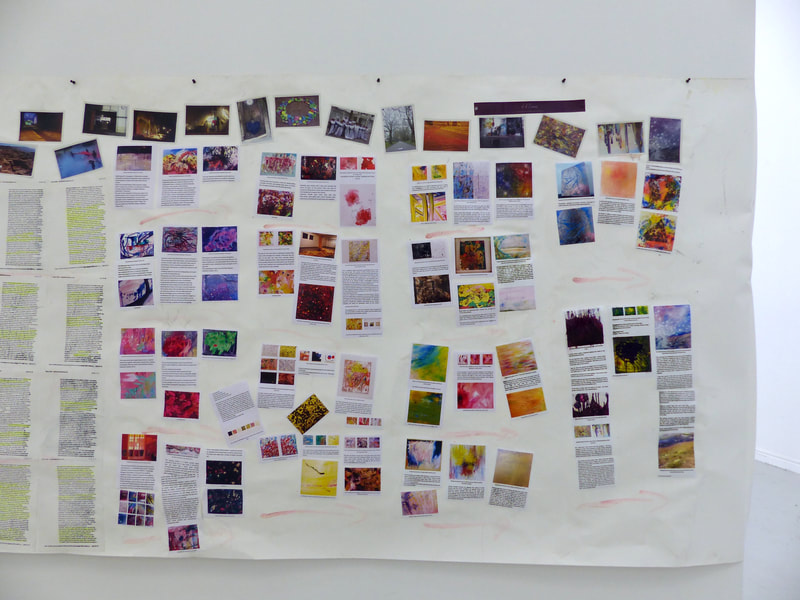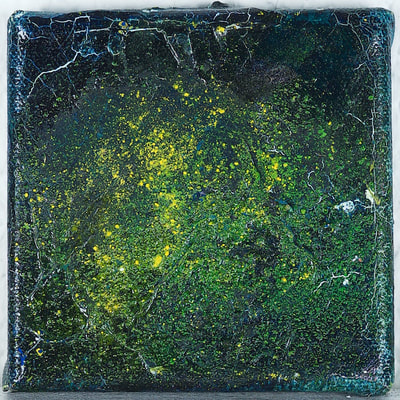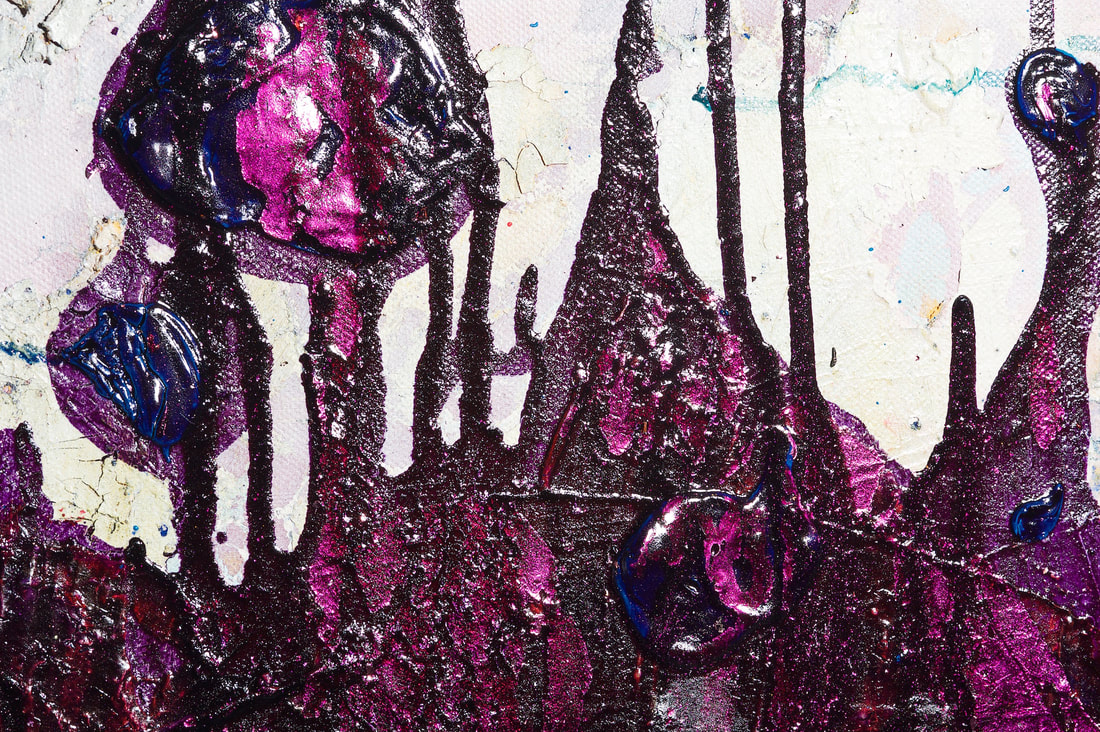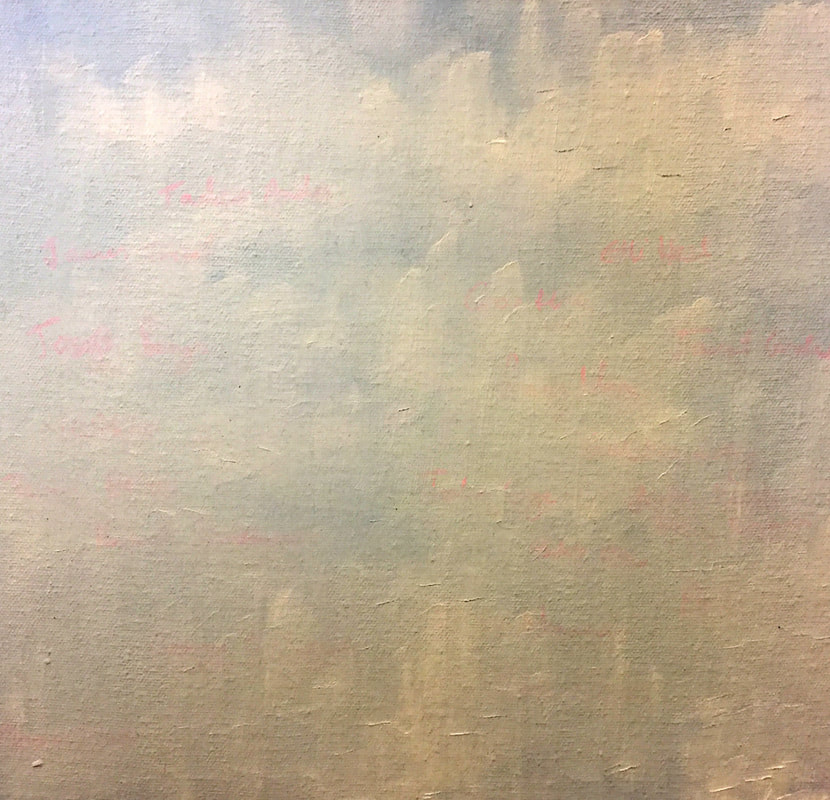|
Statement
My art practice is rooted in painting, both studio based with archival properties and temporary in the great outdoors recorded photographically. The paintings, installations and artists books that I make are generated from life experience and particular locations, forming an external narrative that supports further research and works. Curiosity regarding how we interact with each other and the world, with an emphasis on double edges (violence, peace, greed, oneness) underpins my practice and has led to studies in trauma therapy, eco design, martial arts and rock climbing. These in turn fuel time spent in diverse urban and rural environments, which further inform my line of enquiry. During the making process I explore memory formation, using act of painting to embed felt and transient experiences, whilst experimenting with how concepts and observations can be conveyed. I attempt to portray environmental and psychological phenomenon in my artwork, such as a hurricane forming from the ocean edge, brocken spectre on a mountaintop, a fleeting sense of oneness in the city, acceptance stirred by the desert sky or a city park at dusk. Recalling the feeling of the elements when painting landscapes, to help capture and communicate something of the essence of these moments, can be replenishing and a form of action research. Painting with traditional materials has also proven valuable for processing and thinking through adversity, both on a personal level and for some of the communities that I have worked with. My paintings and photographs of temporary works bear witness to existence, akin to the function of a postcard or personal photo album; the format of which have changed dramatically with the growing role of digital media over the last two decades. Positioning my artwork across the spheres of photography, psychology and environment is not only theoretical but the work is often site specific for political and practical reasons. My temporary paintings have been made in quarries / landfill sites, parks, with Ibizan goats, Surrey sheep, the ocean, underpasses and an overpass, a farmer and a fire brigade. In recent years librarians have helped to share my studio based paintings and hand bound books. Training: Fine Art (Ba Hons’) John Moore’s University, Liverpool Design for Environment (Masters) Chelsea College, London Art Psychotherapy (Masters) Goldsmiths University, London ------- Below you can explore studio based works spanning seven years, where I used paint on traditional flat surfaces to reflect on and respond to life as it happened. Sharing the process behind these works, which took many forms before they were complete, is an ongoing endeavour. The body of work is titled 'Polaris'. Remembering the desert at close to midnight, mainly oil paint on linen, some spray paint, gold and silver leaf and varnish (2017), Woolwich, London This landscape was influenced by some time spent Ourzazate in Morocco in 2013 and I painted the memory throughout 2017. The piece went through many phases, with the ground shifting and changing through green meadows to seas - somehow representing the variety of places we can star gaze from. Eventually I scraped away the paint from the earth element and made the canvas smooth to start anew the following day. On return I found the mood of the painting now encompassed that of the memory and felt great relief, with a touch of ecstasy, when I realised that the painting was complete. I hope that viewers of this work can connect to the place and emotion on their own terms. We all live under the same sky, suffer joys, losses, breathe the same air and I found this place and the creation of this painting synonymous with many other landscapes, times and places. I let it hang in the studio for some months after creating it, people would come to sit and talk with me about their lives and the painting made a comfortable background for all of them. Something about the working through having reached a resolution supported this, with marks from the process remaining prominent and unhidden being essential to the resulting calm. I hope it will bring out a sense of acceptance, contemplation and peace to viewers, though equally valid would be to explore the use of material, with three dimensional smears of paint appearing to be in the background and scratches that go right through to the base layer appearing to be in the foreground. Traditional painting styles have been drawn from - as have contemporary methods. The linen was prepared with rabbit skin glue and painted with hand mixed oils, along with gold and silver leaf, spray paints, varnish, inks and action painting; the mixing and application of paint was at times very playful, videoed and shared on social media. This painting concluded a seven year series, whereby I allowed myself to paint in a responsive way, behind closed doors mainly in art studios. Much of my artwork takes place outside, in public with site specific elements; the studio based paintings were to develop my painting practice in it's own right, reclaiming it. Events, people and places encountered also created motivation for and influenced many of the paintings. Midnight detail, mainly oil paint on linen, some spray paint, gold and silver leaf and varnish (2017), Woolwich, London
Phosphorescence, Lichen and Knot, oil paint, varnish and raw pigment on canvas, 3 10x10 cm (2017) Woolwich, London UK Phosphorescence, Lichen and Knot (above, left to right) Parts of the landscape noticed whilst swimming, climbing, hiking - replicated with artificial materials. Moss (image below) As above - before the spillage. Moss, oil paint, varnish and raw pigment on canvas, 25 x 25 cm (2017) Woolwich, London UK
Quality Street, varied paints and varnish on canvas, 100 x 100 cm (2016), Woolwich, London A sturdy surface coating a temporary painting that melted (it was titled #hottestdayoftheyear). On 3rd September 2016, cycling to the studio I passed people basking in the sun drinking cold drinks as if it were July in the Costa del Sol, but it was Woolwich in September. What else to do but melt in the studio whilst trying to paint it? Later on, when the painting had melted too (or I'd wrecked it), I turned it into one of those Big Purple Ones - the best Quality Street was jumbo size for a while - shiny purple wrapping dressed and protected the chocolate and central hazelnut . That wouldn't stand much of a chance in the current heat either. * Grandma's hands was also made prior to this, a painting with flowers, which changed over time. That and #hottestdayoftheyear both sit with my projects rater than paintings - they fit somewhere between the studio based practice and installation work. *At the time of writing nearly two years on it's hotter. The nearby common is literally on fire - over a hundred firemen. Quality Street detail, varied paints and varnish on canvas, 100 a 100 cm (2016), Woolwich, London Grandma's Hands),157x108 cm, flowers (2015), and #Hottestdayoftheyear (2016) 150x150 cm PS. I read from a few sources that the revolution / civil war / massacres in Syria were prompted by climate change. Apparently droughts made life too hard for farmers, who came to the city and peaceful protests ensued. Further triggers and violence used on the protestors escalated things to the Revolution at the time of the Arab Spring. International support, that was expected by the Free Syrian Army (2012), was late coming; 'others' piled in with other agendas, millions of citizens became refugees and hundreds of thousands were killed. As the conflict and weather becomes more extreme so does my love of ice-cream.
In 2008 when Israel was bombing Gaza I was briefly in Bethlehem (Palestinian territory); there was so much tension and fear in the air due to this war - it was intense. Around a week later, whilst it was still going on I sat on a street bench in Tel Aviv with two journalists I'd met in Palestine, gazing at people (normal people - citizens) walking along eating ice-cream, seemingly without a care. Following this I went to Jordan and found some normality night climbing with a German and a Bedouin - the hardest route I'm ever likely to do - I wasn't a rock climber until then. After the bubble of Israel and witnessing the repression and deprivation on the Palestinian side of the division wall, open space with no walls as far as the eye could see seemed vital and was sheer bliss. I eat a lot more ice-cream these days - as the world gets smaller. Nermuda, acrylic, emulsion and foil on canvas, 25 x 25 cm, (2015), Woolwich, London Primary colours and alien ships, an ode to Matisse and The Bermuda Week. I am shocked there is no such word as Nermuda. How can that be? The Bermuda Week, acrylic, emulsion and foil on canvas, 25 x 25 cm, (2015), Woolwich, London
ARLTR, Oil on canvas, 25 x 25 cm,(2015), Woolwich, London In ARLTR (All roads lead to Rome) the primary colours are included as representative of combined ideas, disciplines of knowledge, religious and ethnic groups. The reason for this title is the feature runs throughout my painting and installation practice - it so often comes back to the possibilities of combinations and also respect of the singular or 'pure' if there is such a thing.
The theme is a vehicle to explore combative and violent aspects of the human nature as inseperable from our sociable nature and ability to harmonise with the natural world, whilst we also destroy what we can of it. The temporality of this existence and how we experience and navigate space and time are referenced with traces of activity or photographic snapshots of temporary pieces. Thumbprint, oil paint, gloss paint and foil on canvas, 25 x 25cm (2015) Woolwich, London Thumbprints - typically in the domain of forensics - have begun to replace passwords, which have partially replaced signatures. Thumbprint detail, oil paint, gloss paint and foil on canvas, 25 x 25cm (2015) Woolwich, London
Names, ink and acrylic paint on canvas 30x30 cm (2015) Woolwich, London Thinking about how memory functions and ideas form, some names of people who influenced me are included in this painting: some invisible, some very faint. These are people I have not met, though a similar phenomenon can also occur with people whom I have; the nature of being where all experiences influence and touch our lives, they change and inform us though exactly who, where and what can be hard to pin down and sometimes impossible to know as it all mushes together. The name is abstract and removed from the essence of the person yet so central. With creative and academic inspirations I prefer to think of the peoples' and movements' names as signposts rather than labels and categories.
Whilst making this painting I posted it on social media, Dia Batel - an artist I respect (a print of hers is on my wall) gave it a like; which prompted me to consider how the way people fade from the world was also a factor. Names are so often the point of reference when we commemorate that people existed, their ideas, contributions and deaths. The pink text on the blue background sort of enveloped in mist does give that impression, more than intended. Below is a cross-section of practitioners whom I found encouraging and informative between 1995-2015. These names were all visible in the above painting at some point. These were the first thirty that sprang to mind. Tadao Ando (natural elements in architecture), Shirley Bassey (voice and style), Roland Barthes (The World of Wrestling), Joseph Beuys (tree planting), John Bowlby (attachment theory), David Bowie (imagination), The Boyle Family (Earth Pieces), Kate Bush (originality and timelessness), John Cage (Silence), Janet Cardiff (sound walks), Jeremy Deller (Folk Archive), Peter Doig (Blotter), Pink Floyd (album covers and music), Nils Fram (solo music), Jenny Holzer (text projections), Goethe (colour theory), Mona Hatoum (installation), Georgia O'Keeffe (Radiator Building) Melanie Klein (Envy and Gratitude), Yves Klein (signing the sky and painting with models), Richard Long (A Line Made By Walking), Bruce Lee (good name, great high kick - one of a kind), Yoko Ono (Secret Piece), Mark Rothko (fading, glowing paintings), Jenny Saville (nudes as a YBA), Francis Shapiro (bilateral eye movements), Robert Smithson (Earthworks), James Turrel (Crater Spaces), Lao Tzu - name given (Tao Te Ching), Sun Tzu (The Art of War), Paul Virilio (time-space compression and the architecture of movement). Invisible City, oil on linen, 170 x 200cm (2015) Woolwich, London This oil painting was created whilst listening to a lot of Nils Fram's music, it particularly got going to 'Toilet Brushes'. Whilst thinking about housing (developments) within cities, within countries I also remembered the book Invisible Cities by Italo Calvino that I had read more than a decade before. 'The group of buildings look a bit like a tooth that has been removed, and they could be anywhere.' I took the painting off the stretcher when showing it alongside paintings by Rabee Kiwan in 2015, in the project NEW . It felt more fitting to have raw edges. Invisible City detail, oil on linen, (2015) Woolwich, London
Mixing, raw pigment and varnish on canvas, 30x30cm (2015) Woolwich, London 'Mixing', included dropping raw pigments (for making oil paint) directly onto the canvas, resulting in an aesthetic closer to my temporary outdoor paintings than most of the studio based pieces. The concept underpinning this painting was quite specific socio-politically, though when you pan out it merges with threads running throughout my practice. I find it interesting how concepts and techniques can weave through projects and paintings year upon year in seeming endless guises.
|
|


































